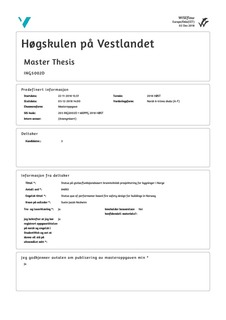| dc.description.abstract | Performance-based building codes with functional requirements were originally developed to allow for a more goal-oriented approach to building design. Development work started in the 1970s and was deemed sufficiently mature enough to be fully implemented in the early 1990s. Performance-based building codes are however still very much in development, and in various stages of implementation in different countries around the world. The countries that implemented performance-based codes at an early stage now have multiple years of practical experience with using them. This experience has revealed issues related to the practice of performance-based design with fire safety that must be fixed if it is to be recognized as a robust and safe design approach. Two major issues are identified: lack of, or unclear, performances linked to functional requirements in the building codes, and a high degree of variability in verification of performance-based fire safety design (PBFSD) between building designers.
Norway introduced its first version of a performance-based building code with functional requirements for fire safety in 1997 (TEK97), allowing for compliance to the building code either by pre-accepted or alternative performances. The functional requirements for fire safety were developed through research efforts by The Nordic Committee on the Building Regulations (NKB) and were mostly qualitative. Some performances linked to the functional requirements were also suggested but found lacking by the building code developers and were not included. As such it was not possible identify a defined fire safety level from these functional requirements. In the transition to the new performance-based building code it was however also a requirement that the acceptable fire safety level was to remain unchanged. This fire safety level in the previous (prescriptive-only) building code was implicitly defined by prescriptive requirements, which were a collection of both performances and technical solutions. Since there was a need for performances in the new building code to define the fire safety level, a decision was made to take these prescriptive requirements from the previous building code and convert them to new pre-accepted performances. These pre-accepted performances were then attached to a relevant functional requirement where they were deemed fitting. Such it became to be that the fire safety level in the new performance-based building code was in effect defined implicitly by building requirements given by the previous prescriptive building code. This type of system is still in current effect. This is considered an issue for practice of performance-based fire safety design, as the acceptable fire safety level is unclearly defined. A change in the building code is suggested where the fire safety level is identified more by quantitative operative requirements (performance requirements) linked to the functional requirements instead of the current pre-accepted performances. Suggestions to achieve this for select areas for fire safety in the building code are given.
Many of the functional requirements in the Norwegian building code have remained largely unchanged over the following 20 years. Most of these requirements were written based on qualitative goals or functional objectives, which is how they are supposed to work in a performance-based building code. A few requirements were however written with the expectation of specific fire safety measures in mind, like use of fire compartmentation, and that exits from fire compartments must lead to an escape route defined as a separate fire compartment. Practical experience with these functional requirements over the years have revealed that they can come into conflict with modern building designs where openplan configurations are desired. There are indicators that these functional requirements may lead to less use of fire compartmentation in such buildings just to avoid conflict with compliance. Such issues should be avoidable, and suggestions to rewrite these functional requirements are given to achieve this.
A fire safety verification method (FSVM) is a measure pursued by several countries around the world to better control the quality of verification in PBFSD. These countries have seen much of the same symptoms that can currently be found with verification in Norway. Whether Norway also should also pursue a FSVM to improve the quality therefore seems to be a reasonable question to ask. Based on investigated literature and expert interviews, the author does not recommend pursuing what is defined as a full scope of compliance FSVM. A limited scope of compliance FSVM may however be justifiable. The optimal path however, is considered to be a recognized fire safety engineering guidance document, created and maintained by a third party, preferably as a collaboration effort in the fire safety community. | nb_NO |

